Last updated on October 23rd, 2023 at 08:55 pm
If you do not have enough space for a large garden pond, a mini pond is a real alternative. Birds and insects discover it as a source of water and habitat. We present 18 suitable pond plants.
Contents
- 1 To the point
- 2 Mini ponds
- 3 Plants from A – F
- 4 Frogbite (Hydrocharis morsus-ranae).
- 5 Frogspoon (Alisma plantago-aquatica)
- 6 Plants from G – J
- 7 Yellow juggler’s flower (Mimulus luteus)
- 8 Yellow marsh iris (Iris pseudacorus)
- 9 Common floating fern (Salvinia natans).
- 10 Common fir frond (Hippuris vulgaris)
- 11 Common Loosestrife (Lythrum salicaria).
- 12 Horned dock (Rumex sanguineus)
- 13 Plants from K – R
- 14 Corkscrew pea (Juncus effusus spiralis)
- 15 Cuckoo carnation (Lychnis flos-cuculi)
- 16 Plants from S – U
- 17 Sea-can (Nymphoides peltata)
- 18 Swamp calla (Calla palustris)
- 19 Marsh Forget-me-not (Myosotis palustris)
- 20 Plants from V – Z
- 21 Water hyacinth (Eichhornia crassipes)
- 22 Water mint (Mentha aquatica).
- 23 Water plant (Egeria densa)
- 24 Dwarf bulrush (Typha minima).
- 25 Dwarf water lily (Nymphaea tetragona)
- 26 Frequently asked questions
- 27 Can I place a mini pond on a balcony?
- 28 What do I do with the mini pond in winter?
- 29 Can the dwarf water lily tolerate a fountain?
- 30 Does a mini pond provide good conditions for fish?
- 31 Author
To the point
- Space for a mini pond is in the smallest garden
- old wine barrels, tubs or disused containers are suitable
- several mini ponds can be combined
- important habitat for insects and water source for birds and small animals
Mini ponds
You want a pond in the garden, but you have too little space? Then try a mini pond. The small pond is quickly created. You need:
an old container, for example a wine barrel that has been sawn through or an old zinc tub
- pond liner
- large stones
- pebbles
- plant baskets
- pond plants
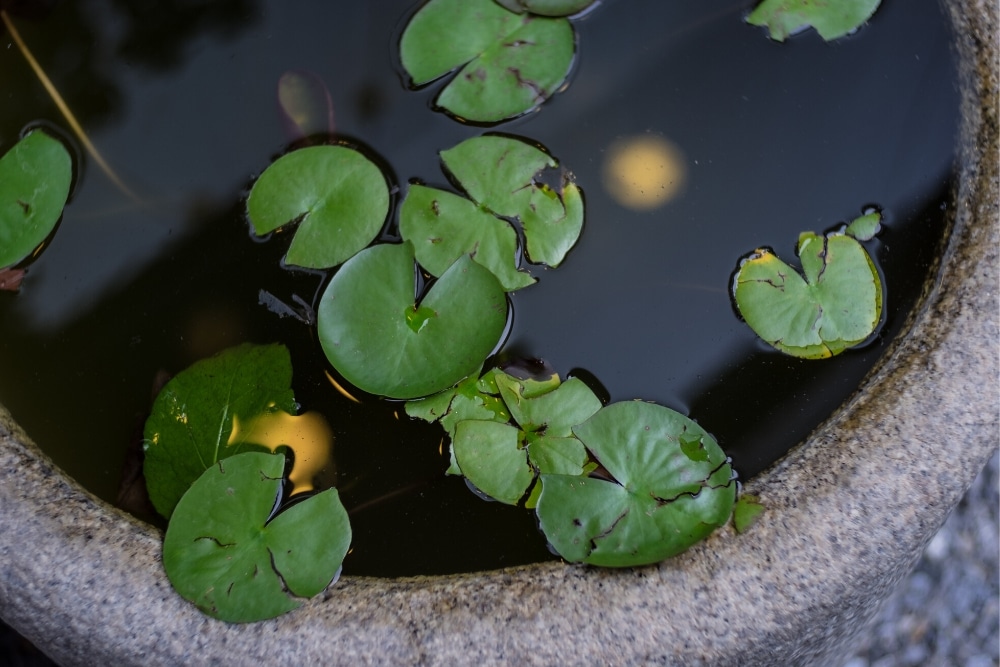
Pond plants with different requirements are suitable for the mini pond:
- Swamp plants require shallow water with a water depth between 0 and 10 centimeters.
- Floating plants are aquatic plants that move freely in the water. Their roots have no contact with the bottom.
- Floating leaf plants need a certain depth of water and connection to the bottom.
- Submerged plants root at the bottom and have no connection to the water surface.
Plants from A – F
Frogbite (Hydrocharis morsus-ranae).
The frogbit belongs to the floating plants. It moves freely in the water. With white flowers, the aquatic plants look very decorative in the small garden pond.

- Water depth: 20 to 40 centimeters
- Flowering time: May to August
- Flower color: white with yellow flower center
- Habitat: sunny to semi-shady
- Height of growth: 10 to 15 centimeters
- Hardy: yes
- Water quality: calcareous
- Special features: Water and soil low in nitrogen
Note: Frogbit gets its name from the shape of its green leaves, which resemble a frog’s mouth.
Frogspoon (Alisma plantago-aquatica)
The frogspoon reaches a growth height of up to one meter. This makes it seem very large for a mini pond. Use only a single plant.
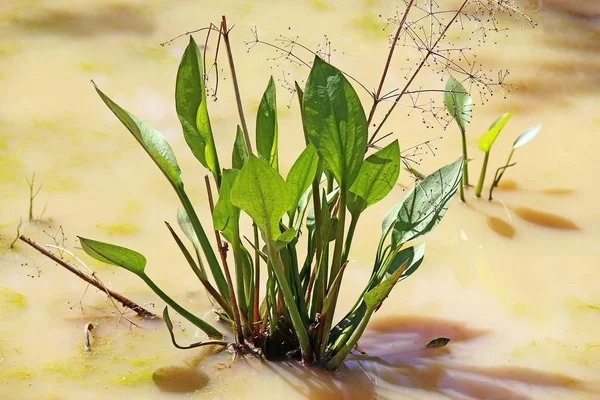
- Water depth: 5 to 10 centimeters
- Flowering time: June to August
- Flower color: white
- Habitat: sunny to semi-shady
- Height of growth: 40 to 100 centimeters
- Hardy: yes
- Water quality: low in lime
- Special features: water purifying properties
Tip: The flowers of the frog spoon are beautiful. They are even suitable as a cut flower in the vase.
Plants from G – J
Yellow juggler’s flower (Mimulus luteus)
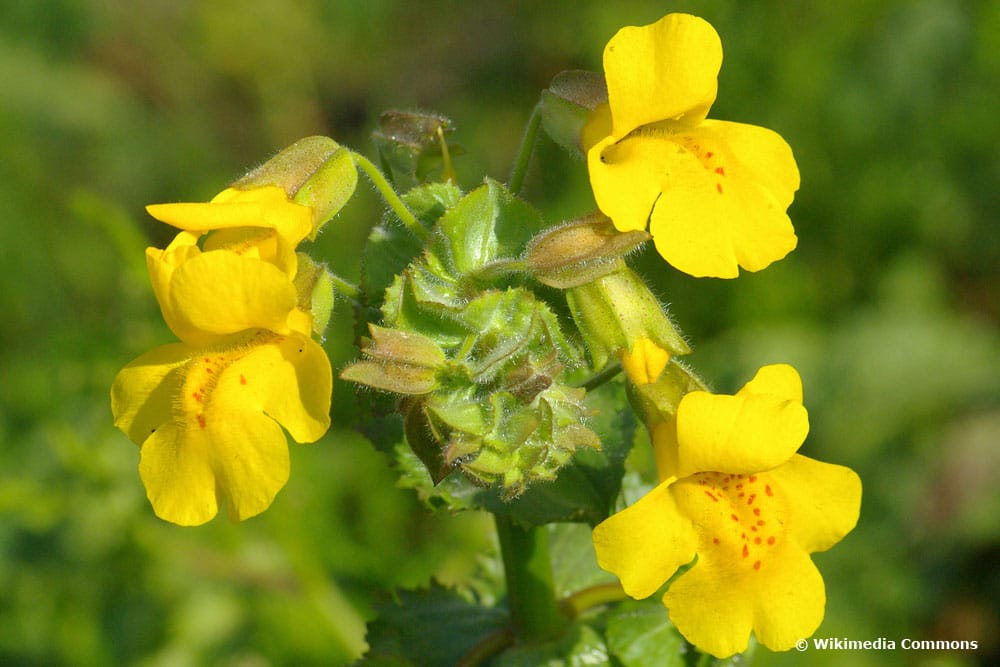
Yellow bateleur flowers are a splash of color in your small pond with their bright yellow blooms. These aquatic plants make a great contrast next to dark blue or purple pond plants.
- Water depth: 5 to 10 centimeters
- Flowering time: May to July
- Flower color: yellow
- Habitat: sunny to semi-shady
- Height of growth: 30 to 40 centimeters
- Winter hardiness: frost hardy
- Water quality: low lime
- Special features: Pruning in autumn recommended
Yellow marsh iris (Iris pseudacorus)
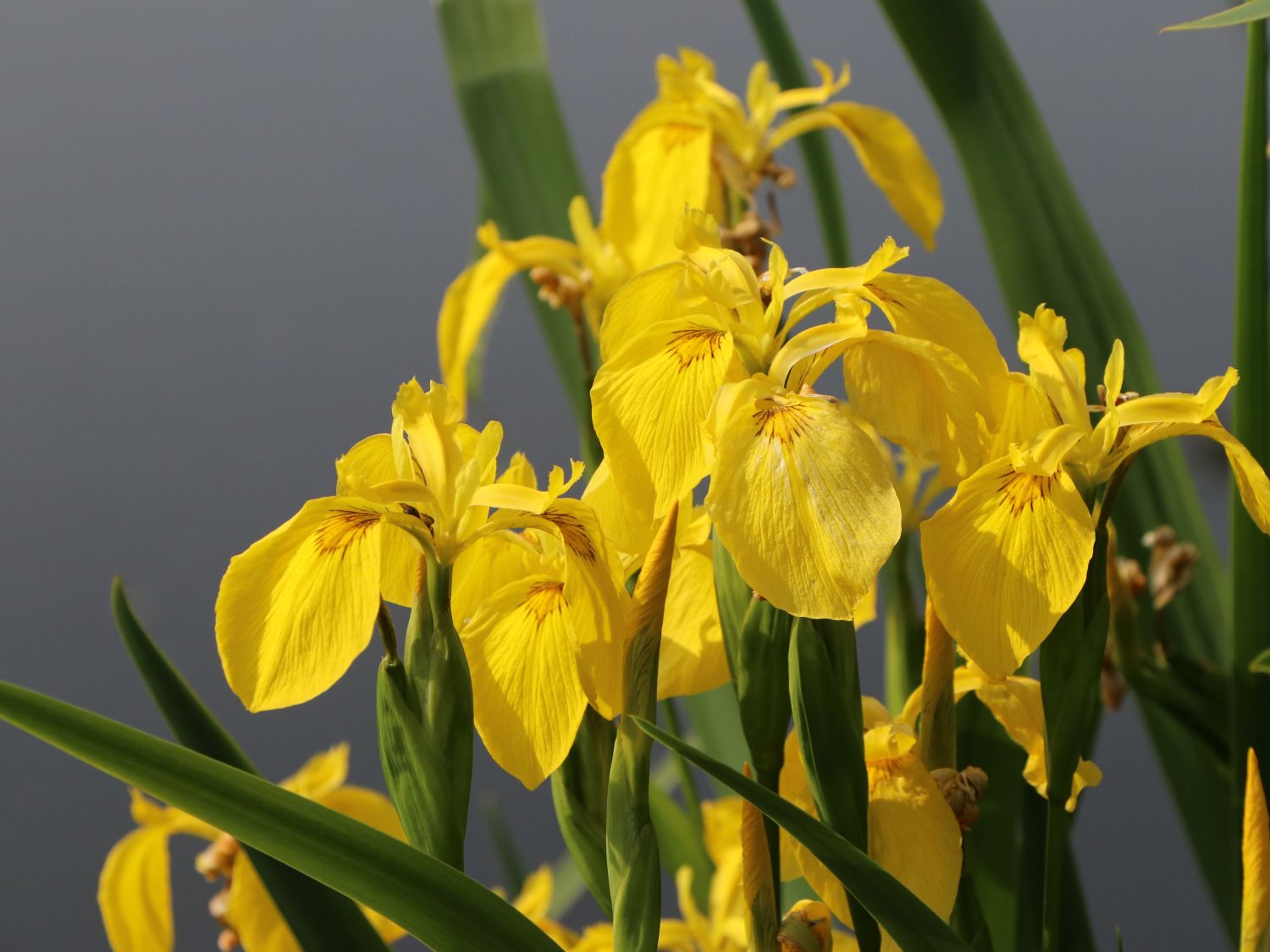
Yellow marsh irises are well suited for planting in small ponds. The flowers of the aquatic plants shine from a distance.
- Water depth: 10 to 30 centimeters
- Flowering time: May to June
- Flower color: yellow
- Habitat: sunny to semi-shady
- Height of growth: 60 to 120 centimeters
- Winter hardiness: frost hardy
- Water quality: neutral
- Special features: strong growth, always use a planting basket for planting
Common floating fern (Salvinia natans).
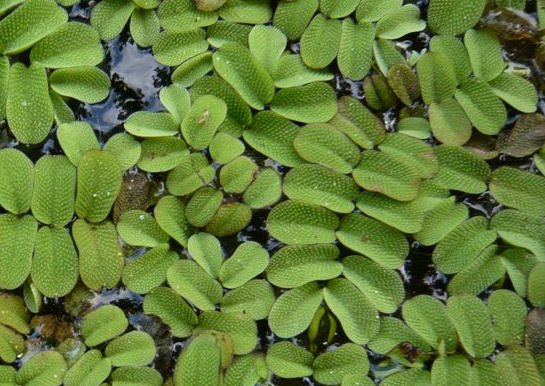
The common floating fern does not look like a fern with its elliptically shaped, felt-like leaves. You can plant a mini pond in a sunny location with this robust floating plant. The leafy ornamental plant does not form flowers.
- Water depth: from 10 centimeters
- Location: sunny
- Height of growth: 5 to 10 centimeters
- Winter hardiness: frost hardy
- Water quality: calcareous
- special features: parts are removed in case of strong spreading
Common fir frond (Hippuris vulgaris)
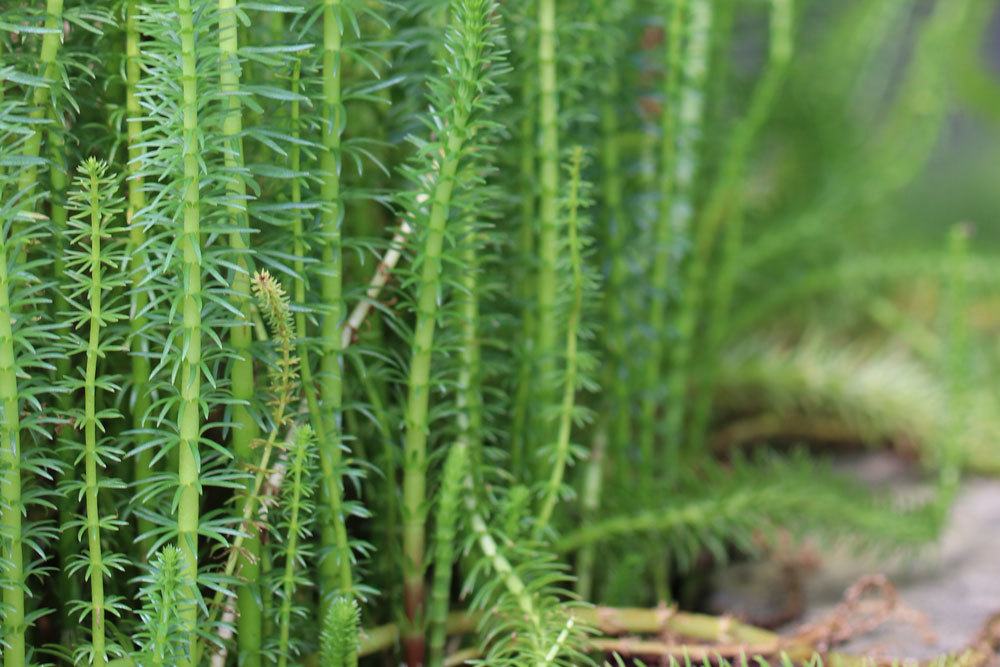
The stems of the common fir frond resemble fir branches with their whorled leaves.
- Water depth: 10 to 20 centimeters
- Flowering time: May to July
- Flower color: pink
- Habitat: sunny to semi-shady
- Height of growth: 40 to 60 centimeters
- Winter hardiness: frost hardy
- Water quality: neutral
- Special features: popular bee forage plant
Common Loosestrife (Lythrum salicaria).
Purple loosestrife is a decorative perennial for shallow water and marshy areas. Various hybrids with flowers in different shades of red and pink are available in garden stores. The medicinal plant got its name because of its hemostatic effect.
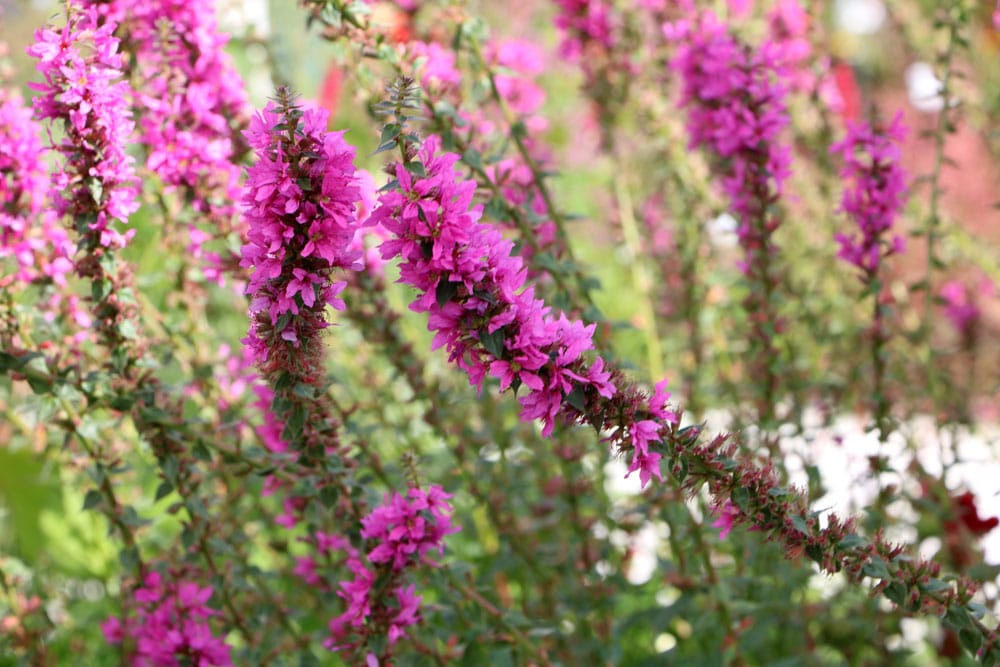
- Water depth: 5 to 10 centimeters
- Flowering time: June to September
- Flower color: pink, purple
- Life span: perennial
- Height of growth: 70 to 80 centimeters
- Hardy: yes
- Water quality: calcareous
- Special features: The pink flower candles de water plants attract bees, bumblebees, dragonflies and butterflies.
Horned dock (Rumex sanguineus)
The wood sorrel or pond sorrel belongs to the knotweed family. With its green leaves interspersed with blood-red leaf veins, it is suitable for planting in the mini pond.

- Water depth: 5 to 10 centimeters
- Flowering time: July to September
- Flower color: creamy white
- Habitat: sunny to semi-shady
- Height of growth: 40 to 60 centimeters
- Winter hardiness: frost hardy
- Water quality: low lime
- Special features: high nutrient requirement
Tip: We recommend placing the grove moth in a small pond in a planting basket filled with pond soil to satisfy its high nutrient needs.
Plants from K – R
Corkscrew pea (Juncus effusus spiralis)
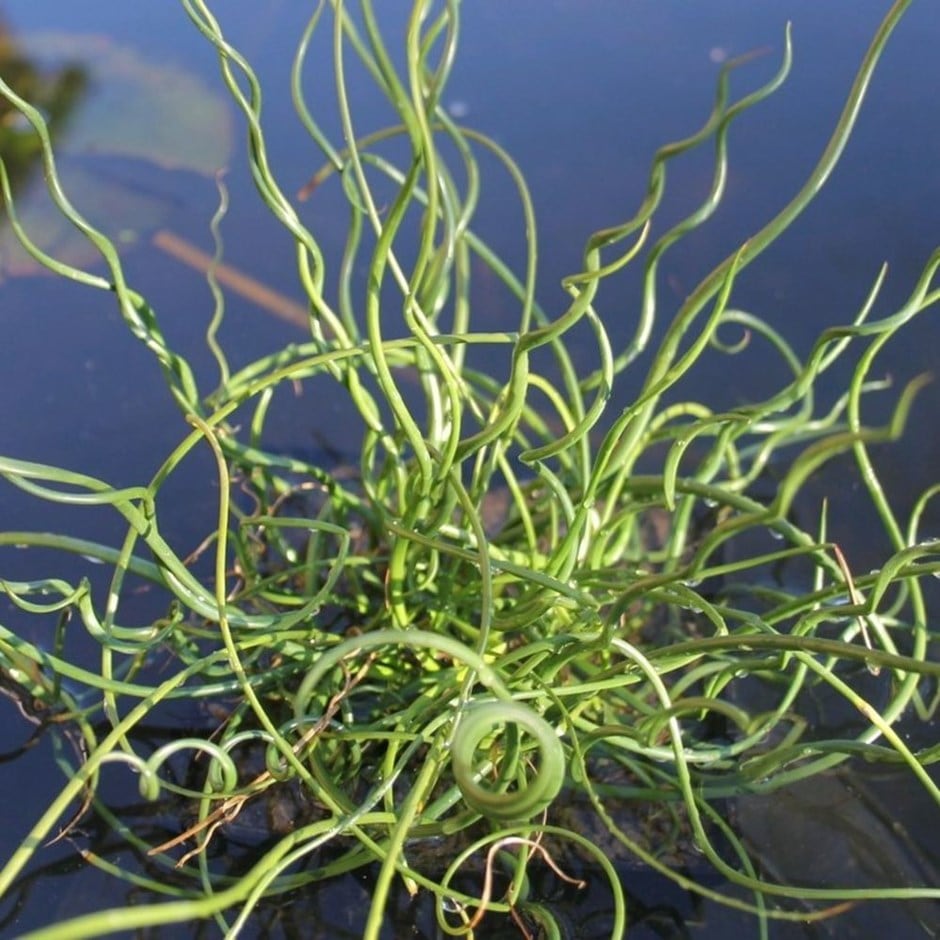
Corkscrew pea impresses with the corkscrew-like shape of its stems. Its brown flowers appear from July.
- Water depth: 10 to 15 centimeters
- Flowering time: July to August
- Flower color: brown
- Habitat: sunny
- Height of growth: 25 to 30 centimeters
- Hardy: yes
- Water quality: neutral
- Special features: Pruning in autumn
Cuckoo carnation (Lychnis flos-cuculi)

Plant your mini pond with cuckoo carnations! The aquatic plants bring exotic flair to your garden with their delicate flowers.
- Water depth: 0 to 5 centimeters
- Flowering time: May to July
- Flower color: pink
- Habitat: sunny to semi-shady
- Height of growth: 40 to 60 centimeters
- Winter hardiness: frost hardy
- Water quality: low in lime
- Special features: popular bee forage plant
Plants from S – U
Sea-can (Nymphoides peltata)
With its large leaves, the sea pot provides shade in the mini pond and prevents the formation of algae. The floating plant with the yellow, frayed leaves is popular with dragonflies and water striders.
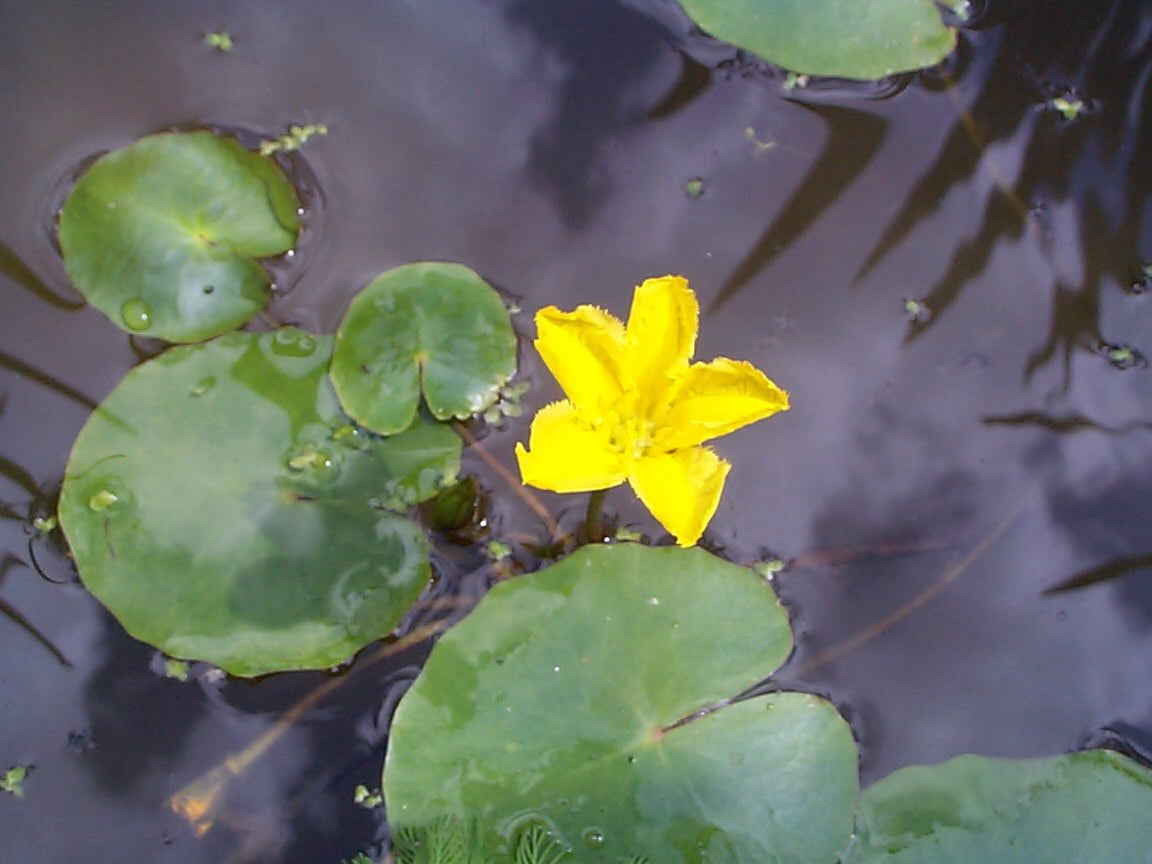
- Water depth: 30 to 50 centimeters
- Flowering time: July to September
- Flower color: golden yellow
- Habitat: sunny
- Height of growth: 5 centimeters
- Hardy: no
- Water quality: low in lime
- Special features: finds excellent conditions in small ponds
Swamp calla (Calla palustris)
For planting ponds in shady and semi-shady locations, the marsh calla is excellent.

- Water depth: 0 to 10 centimeters
- Flowering time: May to July
- Flower color: white-light green
- Habitat: shady to semi-shady
- Height of growth: 20 to 30 centimeters
- Winter hardiness: frost hardy
- Water quality: low in lime
- Special features: slightly poisonous in all parts of the plant
Marsh Forget-me-not (Myosotis palustris)
Plant your mini pond with the romantic marsh forget-me-not! When the charming plant feels comfortable, it will seed itself.
- Water depth: 0 to 5 centimeters
- Flowering time: May to September
- Flower color: light blue or white
- Habitat: sunny to semi-shady
- Height of growth: 30 to 70 centimeters
- Winter hardiness: up to -20 degrees Celsius
- Water quality: low-calcium water
- Special features: Pruning after first flowering is recommended

Plants from V – Z
Water hyacinth (Eichhornia crassipes)
The water hyacinth originates from Brazil. The bubbles on the stems and the air-filled tissue give the floating plant the necessary buoyancy. It multiplies quickly. If the humidity is high enough in summer, it produces beautiful flowers.

- Water depth: 20 to 40 centimeters
- Flowering time: May to August
- Flower color: blue-purple
- Habitat: sunny to semi-shady
- Height of growth: 10 to 15 centimeters
- Winter hardiness: no
- Water quality: low lime
- Special features: Flower formation only with high humidity
Note: Planting a water hyacinth in the mini pond will help purify the water.
Water mint (Mentha aquatica).
Water mint impresses with its delicate fragrance. Bumblebees and bees also love it. If you like, you can prepare a tasty tea from the mint leaves.

- Water depth: 5 to 10 centimeters
- Flowering time: June to September
- Flower color: light purple
- Habitat: sunny to semi-shady
- Height of growth: 20 to 50 centimeters
- Winter hardiness: frost hardy
- Water quality: acidic
- Special features: popular bee food plant
Water plant (Egeria densa)
The water plant is an underwater plant. It regulates the oxygen content in the mini pond.

- Water depth: 70 to 180 centimeters
- Flowering time: May to September
- Flower color: white
- Habitat: sunny to semi-shady
- Height of growth: 30 to 100 centimeters
- Hardy: yes
- Water quality: lime-rich water
- Special features: regular pruning required
Tip: Water plant is popular for its water purifying properties. It grows very quickly. If you want to cultivate it in a small pond, you must ensure regular pruning.
Dwarf bulrush (Typha minima).
Dwarf bulrush is threatened with extinction in the wild. Give it a protected home in your mini pond. It makes a perfect contrast to the flowering plants with its spherical dark brown cobs.
- Water depth: 5 to 10 centimeters
- Flowering time: June to September
- Flower color: brown
- Habitat: sunny
- Height of growth: 40 to 60 centimeters
- Winter hardiness: yes, overwinters in overwintering buds
- Water quality: calcareous
- Special features: very susceptible to wind, protected location required

Dwarf water lily (Nymphaea tetragona)

A water lily must be! Choose a small variety for the small pond. The dwarf water lily is made for mini ponds.
- Water depth: 30 to 50 centimeters
- Flowering time: June to September
- Flower color: yellow
- Habitat: sunny to semi-shady
- Height of growth: 10 centimeters
- Hardy: yes
- Water quality: calcareous
- Special features: blooms until evening
Frequently asked questions
Can I place a mini pond on a balcony?
You can design a mini pond even on a balcony. Be sure to consider the weight of water, gravel and stones. Choose the size of the mini pond and the vessel to match the load capacity of your balcony.
What do I do with the mini pond in winter?
Note that a mini-pond, which has an average water depth of between 30 and 40 centimeters, does not provide conditions for wintering even hardy pond plants. Likewise, there is a risk that the frozen water will destroy the vessel. Drain the water in the fall and put the pond plants in an aquarium for wintering. If you have the option, you can overwinter the mini pond in the winter garden or greenhouse.
Can the dwarf water lily tolerate a fountain?
Dwarf water lilies do not tolerate constant water movement and splashing water on the flower. Therefore, you should refrain from fountains in the small pond with dwarf water lilies.
Does a mini pond provide good conditions for fish?
Fish in a mini pond are a risky proposition. Space is limited and the permanent nutrient input from fish food is high. Small mini ponds heat up a lot in the summer, so the fish may suffer. We recommend staying away from fish in the mini pond and enjoying the visit of the enchanting dragonflies and insects to the pond plants.


